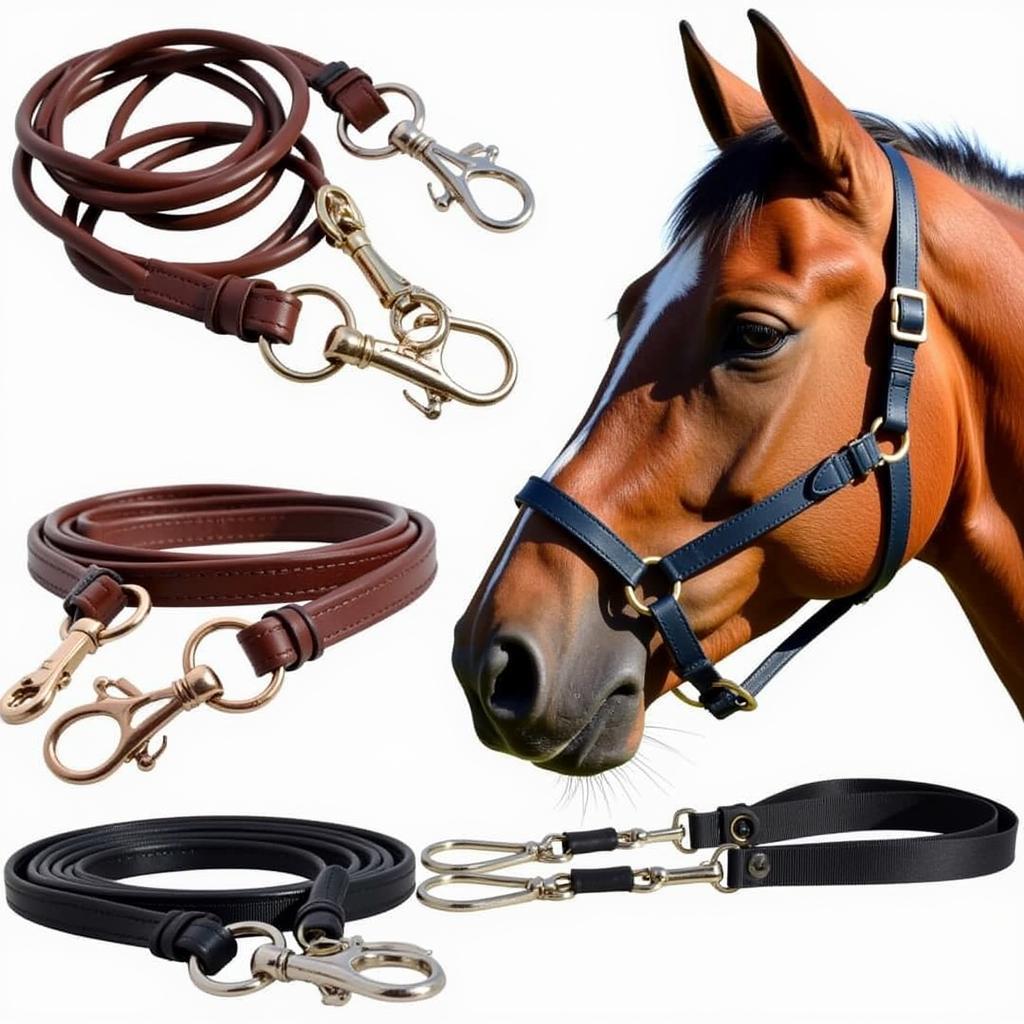Mastering horsemanship involves a deep understanding of your equine partner and the tools that facilitate clear communication. Selecting the right Horse Training Equipment is crucial, whether you’re a seasoned trainer or just starting your equestrian journey. This guide will equip you with the knowledge to make informed decisions about the equipment that best suits your training goals and your horse’s well-being.
The Cornerstones of Horse Training Equipment
Before delving into specialized tools, let’s cover the fundamental equipment no equestrian should be without:
1. Halters and Lead Ropes: Your Communication Lifeline
A well-fitted halter is the foundation of control and guidance. Opt for a durable material like leather or nylon that fits snugly but allows for two fingers between the noseband and your horse’s cheek. The lead rope, your direct line of communication, should be sturdy, comfortable to grip, and an appropriate length for your horse’s size and the training environment.
 Types of Horse Halters and Lead Ropes
Types of Horse Halters and Lead Ropes
2. The Bit: Understanding the “Why” Behind the “What”
The bit is not just a piece of metal; it’s a communication tool that requires careful consideration. The choice of bit depends heavily on your horse’s age, training level, mouth conformation, and the discipline you’re pursuing. Consult with a qualified equine professional or experienced trainer to determine the most suitable bit for your horse, ensuring it promotes comfort and clear communication without causing pain or discomfort.
3. Saddle and Girth: A Foundation of Comfort and Security
The saddle is your primary point of contact with your horse, making a proper fit paramount for both horse and rider. Saddle fitting is a specialized skill best left to professionals who can evaluate your horse’s back conformation and ensure the saddle distributes weight evenly, allowing for freedom of movement. The girth, securing the saddle in place, should be the correct length and material for your horse’s size and girth groove sensitivity.
Specialized Horse Training Equipment: Tailoring Tools to Disciplines
As you progress in your equestrian journey and delve into specific disciplines, specialized equipment becomes essential:
1. Lunging Equipment: Building Foundation and Flexibility
Lunging is an invaluable training tool, allowing you to work your horse without the weight of a rider. Essential lunging equipment includes a lunge line, lunge whip, and a properly fitted surcingle or lunging cavesson. These tools encourage your horse to move forward freely, develop balance, and build muscle, ultimately enhancing their responsiveness under saddle.
2. Groundwork Tools: Fostering Communication and Respect
Groundwork is the foundation of any successful training program, and specialized tools can enhance communication between you and your horse. Consider incorporating tools like a training stick or flag to direct your horse’s movement, a dually halter for more precise cues, and groundwork obstacles to build confidence and develop problem-solving skills.
3. Riding Equipment: Enhancing Communication and Performance
The type of riding equipment you choose directly impacts your communication with your horse while riding. Depending on your chosen discipline, you might consider different types of bits, reins, spurs, and training aids. For instance, tom thumb bit horse riders often utilize specific bits and reins, while dressage riders prioritize subtle aids and a deeper seat connection.
Choosing the Right Equipment: A Partnership Approach
Selecting the appropriate horse training equipment is an ongoing process that evolves with your horse’s training. Remember that each horse is an individual, and what works for one may not work for another.
“Always prioritize the well-being of your horse,” advises renowned horse trainer, Emily Carter. “Equipment should never be used to force a horse into submission but rather to facilitate communication and understanding.”
Conclusion: Equipping for Success, One Step at a Time
Investing in high-quality horse training equipment is an investment in your horse’s well-being and your partnership. By understanding the purpose of each piece of equipment and choosing tools that align with your horse’s needs and your training goals, you pave the way for a safe, enjoyable, and successful equestrian journey. Remember, patience, consistency, and a deep understanding of your equine partner are the most valuable tools in your training arsenal.
FAQs
1. What type of halter is best for training a young horse?
A flat nylon halter is often a good choice for young horses due to its durability and clear pressure points.
2. How often should I have my horse’s saddle checked for fit?
It’s recommended to have your horse’s saddle checked by a qualified saddle fitter at least once a year, or sooner if your horse experiences significant changes in weight or muscle development.
3. Can I use any type of bit for lunging?
It’s generally not recommended to lunge a horse with a bit. A properly fitted lunging cavesson or surcingle is a safer and more comfortable option.
4. What are some essential groundwork exercises for a beginner horse and rider?
Leading, halting, backing up, and yielding to pressure are excellent foundational groundwork exercises.
5. How do I know if my horse is comfortable in its training equipment?
A comfortable horse will exhibit relaxed body language, such as a soft eye, loose jaw, and even breathing. Signs of discomfort include head tossing, teeth grinding, and pinning ears back.
Need more assistance? Don’t hesitate to contact us!
- Phone: 0772127271
- Email: [email protected]
- Address: QGM2+WX2, Vị Trung, Vị Thuỷ, Hậu Giang, Việt Nam.
Our dedicated customer support team is available 24/7 to assist you. You can also find additional resources and articles on our website, including information on horse bridles and bits, packing horses, and horse flat trail.